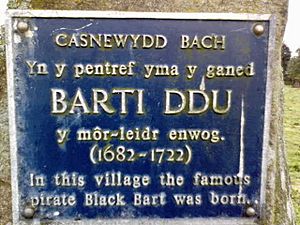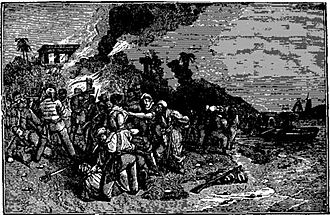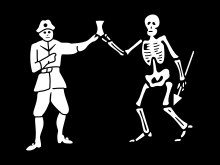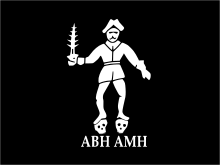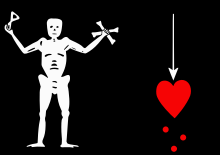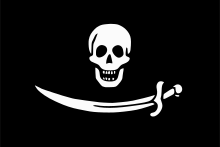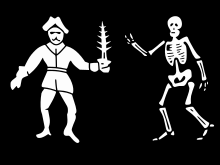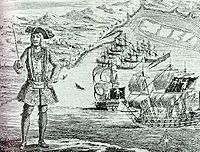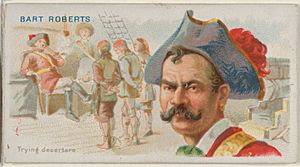Bartholomew Roberts facts for kids
Quick facts for kids
Bartholomew Roberts
|
|
|---|---|
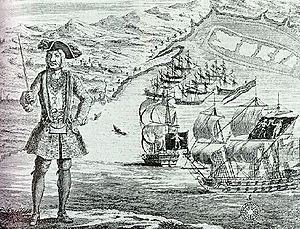
Bartholomew Roberts at Ouidah with his ship and captured merchantmen in the background.
|
|
| Born | 17 May 1682 Casnewydd Bach, near Puncheston, Pembrokeshire, Wales, Kingdom of England
|
| Died | February 10, 1722 (aged 39) At sea off of Cape Lopez, Gabon
|
| Piratical career | |
| Nickname | Black Bart (Welsh: Barti Ddu) |
| Type | Pirate |
| Years active | 1719–1722 |
| Rank | Captain |
| Base of operations | Off the coast of the Americas and West Africa |
| Commands | Royal Rover, Fortune, Good Fortune, Royal Fortune, Ranger, Little Ranger |
| Wealth | 470 vessels |
Bartholomew Roberts (born John Roberts on May 17, 1682 – died February 10, 1722) was a Welsh pirate. He is known as one of the most successful pirates during a time called the Golden Age of Piracy. He captured over 400 ships in his career. Roberts sailed and raided ships near the Americas and the West African coast between 1719 and 1722. He is also famous for creating his own set of pirate rules, known as a Pirate Code, and for using an early version of the Skull and Crossbones flag.
Because of his fame and success, Roberts was called The Great Pyrate and later Black Bart (Welsh: Barti Ddu). He became a popular character in stories and books. Even today, Roberts appears in novels, movies, and video games. He has also inspired fictional characters, like the Dread Pirate Roberts.
Contents
Early life of a pirate
John Roberts was born in 1682 in Casnewydd Bach, a small place in Pembrokeshire, Wales. His father was likely George Roberts. It is not clear why he changed his name from John to Bartholomew, but pirates often used different names. He might have chosen Bartholomew after a well-known buccaneer named Bartholomew Sharp.
Roberts likely started working at sea when he was 13 years old in 1695. However, there are no records of him until 1718, when he was a mate on a ship called a Barbados sloop.
In 1719, Roberts was the second mate on a ship named Princess. This ship was carrying enslaved people under Captain Abraham Plumb. In early June, the Princess was anchored at Anomabu in West Africa (now Ghana). It was captured by pirates. These pirates were on two ships, Royal Rover and Royal James, led by Captain Howell Davis. Davis was also Welsh, from Milford Haven. Roberts and some other crew members from the Princess were forced to join the pirates.
Davis quickly saw that Roberts was a skilled navigator. He often asked Roberts for advice. Davis could also talk to Roberts in the Welsh language, keeping their plans secret from the English and other crew members. Roberts was supposedly not happy about becoming a pirate at first. But he soon realized the exciting chances this new life offered him.
Life as a pirate captain
Becoming a leader
When Roberts worked on merchant ships, he earned less than £4 a month. He had no chance of becoming a captain.
A few weeks after Roberts was captured, the Royal James had to be left behind because of damage from worms. The Royal Rover sailed to the island of Príncipe. Captain Davis pretended his ship was a British warship and was allowed into the harbor. After a few days, Davis invited the governor to lunch on his ship. He planned to take the governor hostage for money.
However, the Portuguese on the island found out they were pirates. They ambushed Davis's group on their way to the fort, and Davis was shot and killed.
The pirate crew needed to choose a new captain. Davis's crew was split into "Lords" and "Commons." The "Lords" suggested names to the rest of the crew. Within six weeks of being captured, Roberts was chosen as captain. This was unusual because he had not wanted to be a pirate. Historians believe he was chosen for his great navigation skills and his strong, clear personality.
Roberts' first action as captain was to lead his crew back to Príncipe. They wanted to get revenge for Captain Davis's death. Roberts and his crew landed on the island at night. They attacked the town, killing many men and stealing everything valuable they could find. Soon after, he captured a Dutch ship, and then two days later, a British ship called Experiment. The pirate ship took on water and supplies at Anamboe. There, the crew voted on whether to sail to the East Indies or to Brazil. They voted for Brazil.
Roberts' bravery and success in this adventure made most of the crew loyal to him. They believed he was "pistol proof" (meaning he couldn't be harmed by bullets) and that they would gain a lot by staying with him.
Adventures in Brazil and the Caribbean (1719–1720)
Roberts and his crew sailed across the Atlantic Ocean. They stopped at the empty island of Ferdinando to get water and clean their ship. They spent about nine weeks off the coast of Brazil but saw no ships. They were about to leave for the West Indies when they found a fleet of 42 Portuguese ships. These ships were in the Todos os Santos' Bay, waiting for two large warships to escort them to Lisbon.
Roberts captured one of the ships. He ordered its captain to point out the richest ship in the fleet. The captain pointed to Sagrada Familia, a ship with 40 guns and 170 crew members. Roberts and his men boarded and captured it. The Sagrada Familia held 40,000 gold coins and valuable jewelry meant for the King of Portugal, including a diamond cross.
Next, the Rover headed to Devil's Island near Guiana to share their treasure. A few weeks later, they went to the River Surinam. There, they captured a small ship called a sloop. When they saw a larger ship called a brigantine, Roberts took 40 men in the sloop to chase it. He left Walter Kennedy in charge of the Rover. The sloop got stuck due to bad winds for eight days. When Roberts and his crew finally returned to their ship, they found that Kennedy had sailed away with the Rover and the remaining treasure.
Roberts and his crew renamed their sloop Fortune. They agreed on new rules, now known as a pirate code, and swore on a Bible to follow them.
In early 1720, they were joined by a French pirate named Montigny la Palisse on another sloop, Sea King. The people of Barbados prepared two well-armed ships, Summerset and Philipa, to stop the pirates. On February 26, they met the two pirate sloops. Sea King quickly ran away. Fortune fought for a while but was badly damaged. It managed to escape. Roberts sailed to Dominica to fix the sloop. Twenty of his crew died from their wounds during the trip.
There were also two sloops from Martinique searching for the pirates. Roberts swore he would get revenge on the people of Barbados and Martinique. He had a new flag made. It showed him holding a flaming sword and standing on two skulls. One skull was labeled ABH (A Barbadian's Head) and the other AMH (A Martiniquian's Head).
Newfoundland and the Caribbean (1720–1721)
The Fortune then sailed north towards Newfoundland. They raided Canso, Nova Scotia, and captured several ships around Cape Breton and the Newfoundland fishing areas. Roberts attacked the harbor of Ferryland, capturing a dozen ships. On June 21, he attacked the larger harbor of Trepassey. He sailed in with black flags flying. In the harbor, he found 22 merchant ships and 150 fishing ships. All these ships were left by their scared captains and crews. The pirates took control of Trepassey without any fight.
Roberts had captured all 22 merchant ships. But he was angry at the captains who had run away from their ships. Every morning, he fired a gun, and the captains were forced to meet Roberts on his ship. They were told that anyone who was absent would have their ship burned. One ship from Bristol was taken by the pirates to replace the sloop Fortune. It was fitted with 16 guns. When the pirates left in late June, all the other ships in the harbor were set on fire.
During July, Roberts captured nine or ten French ships. He took one of them, fitted it with 26 cannons, and renamed it Good Fortune. With this stronger ship, the pirates captured many more vessels. Then they sailed south for the West Indies, joined by Montigny la Palisse's sloop, which had met them again.
In September 1720, Good Fortune was cleaned and repaired at the island of Carriacou. It was then renamed Royal Fortune. This was the first of several ships Roberts would name Royal Fortune. In late September, Royal Fortune and Fortune sailed to the island of St. Christopher's. They entered Basse Terra Road, flying black flags, with their drummers and trumpeters playing. They sailed among the ships in the Road, and all of them quickly lowered their flags in surrender.
Their next stop was the island of St. Bartholomew. The French governor allowed the pirates to stay for several weeks. By October 25, they were at sea again off St. Lucia. There, they captured up to 15 French and English ships in the next three days. Among the captured ships was Greyhound. Its chief mate, James Skyrme, joined the pirates. He later became captain of Roberts' partner ship, Ranger.
During this time, it was said that Roberts captured Florimond Hurault de Montigny, the Governor of Martinique. The Governor was sailing on a 52-gun French warship. He was caught and quickly hanged from his own ship's yardarm. The pirates then turned his ship into the new Royal Fortune. However, some historians say this story might have been made more exciting by Captain Charles Johnson in his book A General History of the Pyrates.
By spring 1721, Roberts' attacks had almost stopped sea trade in the West Indies. So, Royal Fortune and Good Fortune sailed for West Africa. On April 18, Thomas Anstis, the commander of Good Fortune, left Roberts during the night. He continued to raid ships in the Caribbean. Royal Fortune kept going towards Africa.
West Africa (1721–1722)
By late April, Roberts was at the Cape Verde islands. The Royal Fortune was leaking and was left there. The pirates moved to the Sea King, which they renamed Royal Fortune. The new Royal Fortune reached the Guinea coast in early June, near the Senegal River. Two French ships, one with 10 guns and one with 16 guns, chased them but were captured by Roberts. Both ships were taken over. One, Comte de Toulouse, was renamed Ranger, while the other was named Little Ranger and used to carry supplies. Thomas Sutton became captain of Ranger, and James Skyrme became captain of Little Ranger.
Roberts then sailed to Sierra Leone, arriving on June 12. There, a retired pirate named John "Old Crackers" Leadstone told him that two Royal Navy ships, HMS Swallow and HMS Weymouth, had left in April and planned to return before Christmas. On August 8, Roberts captured two large ships at Point Cestos, now River Cess in Liberia. One of these was the frigate Onslow, which was carrying soldiers. Some of the soldiers wanted to join the pirates. They were eventually accepted, but they only received a quarter of a pirate's pay because they were not sailors for most of their lives. The Onslow was changed to become the fourth Royal Fortune. In November and December, the pirates cleaned their ships and rested at Cape Lopez and the island of Annobón. Sutton was replaced by Skyrme as captain of Ranger.
They captured several ships in January 1722. Then they sailed into Ouidah (Whydah) harbor with black flags flying. The eleven ships anchored there immediately lowered their flags in surrender. They were returned to their owners after a payment of eight pounds of gold dust per ship. When the captain of one ship refused to pay, Roberts had his crew board the ship and set it on fire. The captured ships were carrying enslaved people. The one set on fire had about eighty enslaved Africans on board. They died either from the fire or by drowning or shark attack after jumping overboard.
Death in battle
On February 5, 1722, Captain Chaloner Ogle of HMS Swallow found the pirate ships Royal Fortune, Ranger, and Little Ranger being cleaned at Cape Lopez. The Swallow turned away to avoid a shallow area. This made the pirates think it was a merchant ship trying to escape. Some stories say Ogle saw Roberts' ships and turned the Swallow as a trick. The Ranger sailed after the Swallow, commanded by James Skyrme. Once out of sight of the other pirates, the Swallow opened its gun ports and fired. Ten pirates were killed, and Skyrme had his leg shot off by a cannonball, but he refused to leave the deck. In the end, Ranger was forced to surrender, and the surviving crew were captured.
On February 10, the Swallow returned to Cape Lopez and found Royal Fortune still there. The day before, Roberts had captured a ship called Neptune. Many of his crew were not fit for duty, which was bad timing. At first, the pirates thought the approaching ship was Ranger returning. But a sailor who had left the Swallow recognized it and told Roberts while he was eating breakfast.
The pirates' plan was to sail past the Swallow. This meant they would be hit by one round of cannon fire. Once past, they would have a good chance of escaping. However, the helmsman (the person steering the ship) failed to keep Royal Fortune on the right path. This allowed the Swallow to get close enough to fire a second round of cannons. Captain Roberts was killed by grapeshot (small metal balls fired from a cannon). Before his body could be captured by Ogle, Roberts' crew fulfilled his wish to be buried at sea with all his weapons and ornaments. They weighed his body down and threw it overboard after wrapping it in his ship's sail. His body was never found.
Roberts' death shocked the pirate world and the Royal Navy. Local merchants and people had thought he was unbeatable. Some even saw him as a hero.
Aftermath of the battle
The battle continued for another two hours until Royal Fortune's main mast fell. The pirates then signaled for surrender. One crew member, John Philips, tried to reach the gunpowder storage with a lit match to blow up the ship. But two men stopped him. Only three pirates had been killed in the battle, including Roberts.
A total of 272 pirates serving under Roberts were captured during the battle. Of these, 65 were people from Africa who Roberts had freed from slavery. They were sadly sold back into slavery. The rest were taken to Cape Coast Castle, except for those who died on the journey back. 54 were sentenced to death, and 52 were hanged. Two were pardoned. Another twenty were allowed to sign agreements to work for the Royal African Company. Historian Burl said they "exchanged an immediate death for a lingering one." Seventeen men were sent to the Marshalsea prison in London for trial. Some were found innocent and released.
Of the captured pirates who shared where they were born, 42% were from Cornwall, Devon, and Somerset in England. Another 19% were from London. Smaller numbers came from northern England and Wales. About a quarter were from other countries, including Ireland, Scotland, the West Indies, the Netherlands, and Greece.
Captain Chaloner Ogle was rewarded with a knighthood. He was the only British naval officer to be honored specifically for his actions against pirates. He also gained money, taking gold dust from Roberts' cabin. He eventually became an admiral.
This battle was a major turning point in the fight against pirates. Many people believe Roberts' death marked the end of the Golden Age of Piracy.
Roberts' pirate code
Captain Charles Johnson wrote about the rules of Bartholomew Roberts' crew. These rules were like a constitution for the pirates. They helped keep order and fairness among the crew.
About Bartholomew Roberts
Most of what we know about Roberts comes from the book A General History of the Pyrates. This book was published a few years after Roberts died. The book's original title page from 1724 says the author was Captain Charles Johnson. (The book is often printed with Daniel Defoe as the author, because some think "Charles Johnson" was a fake name. But there is no proof that Defoe wrote it, and it's still a debate.) Johnson wrote more about Roberts than any other pirate in his book. He described him as:
Roberts is often shown wearing a red waistcoat with scarlet pants and a bright red feather in his hat. The red clothing might have been to hide any blood during battles. Or it could have been to show that he didn't care about staying hidden. Roberts also wore a large diamond cross, which was said to belong to the King of Portugal.
After his adventures in Newfoundland, a governor from New England said that "one cannot with-hold admiration for his bravery and courage." Roberts hated cowardice. When the crews of 22 ships in Trepassey harbor ran away without fighting, he was very angry that they didn't defend their ships.
Roberts was a typical pirate captain in his love for fancy clothes and jewelry. But he had some habits that were unusual for a pirate. For example, he preferred drinking tea. He is often described as someone who followed the Sabbath (a day of rest), but there is no clear proof of this. The idea that he kept the Sabbath comes from the fact that musicians were not forced to play on that day. This might have just been to make sure the musicians got a day of rest, as they usually had to play whenever the crew wanted.
Black Bart was not as cruel to prisoners as some other pirates, like Edward Low or Francis Spriggs. But he also didn't treat them as well as Samuel Bellamy, Howell Davis, or Edward England. Roberts sometimes gave gifts to captains and crews of captured ships if they cooperated. These gifts could be jewelry or items from the captured cargo.
Bartholomew Roberts in popular culture
- Bartholomew Roberts is one of four pirate captains mentioned in Robert Louis Stevenson's famous book Treasure Island.
- Several historical novels feature Roberts as the main character. These include The Corsair King (1852-53) by Mór Jókai, The Devil's Captain (1992) by Philip Shea, The Requiem Shark (1999) by Nicholas Griffin, and The Devil's Captain (2000) by Frank Sherry.
- Roberts' kidnapping of navigator Harry Glasby in 1720 and Glasby's escape are the basis for the novels Glasby's Fortune (2017) and Glasby's Pirates (2020) by James H. Drescher.
- Many novels and poems have been published in Welsh about Bartholomew Roberts. A notable one is a ballad by I. D. Hooson, which later had music composed by Alun Hoddinott. There is also a novel by T. Llew Jones.
- Roberts appears as a side character in the 2013 video game Assassin’s Creed IV: Black Flag. In the game, he is a special person called a Sage who can open a legendary place called the “Observatory.” Both the Assassins and Templars in the game want to find him.
- In the novel The Princess Bride and its film adaptation, the main character Westley takes on the identity of the Dread Pirate Roberts. This mythical pirate figure was inspired by Bartholomew Roberts.
- Along with Henry Morgan, Roberts is mentioned in Pirates of the Caribbean as a founder of the 'Pirate code' (which includes the rule of Parley).
- Roberts appears as a character you can't play (a non-player character) in the Pirates of the Caribbean: At World's End video game. He is voiced by Fred Tatasciore. He is also in Assassin's Creed IV: Black Flag, voiced by Oliver Milburn.
- In 2020, the Perth Mint released silver and gold special coins (approved by Tuvalu) that show The Royal Fortune ship and Black Bart.
- Fictional characters in the popular Manga and TV series "One Piece" about pirates have names inspired by Bartholomew Roberts. These include Bartholomew Kuma (a powerful Warlord of the Sea) and Bartolomeo "The Man Eater." Both are shown as important opponents of the main character.
See also
 In Spanish: Bartholomew Roberts para niños
In Spanish: Bartholomew Roberts para niños


